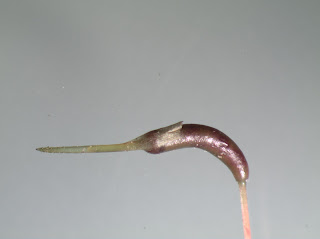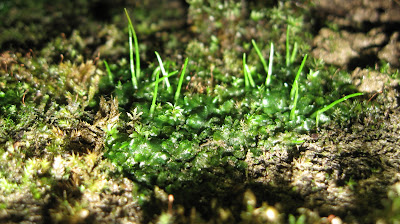 |
| Fig. 1 Drying carpet moss branch next to a ruler with 1mm marks. |
 |
| Fig. 2 Carpet moss leaf, with costa ending below the apex and distinctly elongated margin cells. |
 |
| Fig. 3 Carpet moss next to a quarter. |
 |
| Fig. 4 Carpet moss close up; note the lack of rosette leaf pattern on branches. |
Name: Mnium hornum Carpet Moss
Family: Mniaceae
Family: Mniaceae
Collection Date: Oct. 8, 2011
Habitat: damp soil
Location: Hiram College Field Station woods, Ohio
Description: dark green, tufted, stems unbranched, leaves well defined and large
Collector: Jennifer Friedler
Collector: Jennifer Friedler
Key used: Conard, H.S. and P.L. Redfearn, Jr. 1979. How to Know the Mosses and Liverworts 2nd Edition, McGraw-Hill, Boston, Mass.
Keying Steps:
Introduction key pg. 19
1a. has stem and leaves; erect, ascending, prostrate, or hanging...2
2b. No hayline cells...3
3b. Green...pg. 28. Order Bryidae
Key to Families/Genera Bryidae pg. 28
1b. Green, one layer of cells...3
3b. Leaves in three or more rows...7
7b. No isodiometeric cells...8
8b. Leaves well developed and persistent...9
9b. Has a seta...10
10b. Distinct stem; has operculum...17
17b. Large plant...20
20b. No lamellae...28
28b. Not growing on rich organic soil, bones, or other organic matter...33
33a. Stems erect, tufted, sporophytes terminal...34
34b. No hyaline alar cells...36
36b. Cells smooth...83
83b. Plants growing on rock...85
85b. Larger mosses, stems > 4mm...91
91b stems in five ranks, stem not triangular with outer cells thin walled and colorless...92
92b. Leaves 1-5:1 length...111
111b. Leaves bright or dark green...115
115b. Upper leaf cells quadrate, hexagonal, rhombic, or short rectangular, six times or less as long as wide...118
118b. Uper leaf cells larger...125
125b. Marginal cells slender, not similar to lamina...126
126b. Peristome double...128
(at this point I was back tracking from mnium hornum based off of the information and pictures found at this source: Munch, Susan. Outstanding mosses & liverworts of Pennsylvania & nearby states. New Kingston, PA: Sunbury Press, 2006. Print. due to the fact that my specimen lacked sporophytes)
128b. Leaves not in rosettes...129
129b. Upperleaf cells parenchymatous, mostly hexagonal to round...131
131b. Margins serrate...pg. 129 Mnium
Key to Genus Mnium pg. 129
1b. toothed margins...3
3b. margins with distinct elongated cells...4
4a. marginal teeth double...5
5a. leaves long and narrow, costa ending below apex, toothed on back near apex...Mnium hornum
Links:































